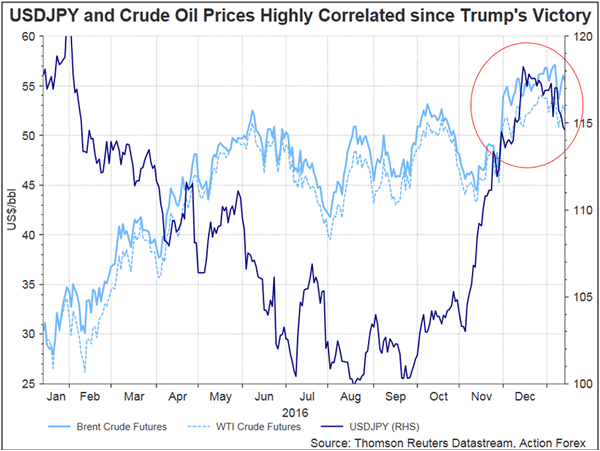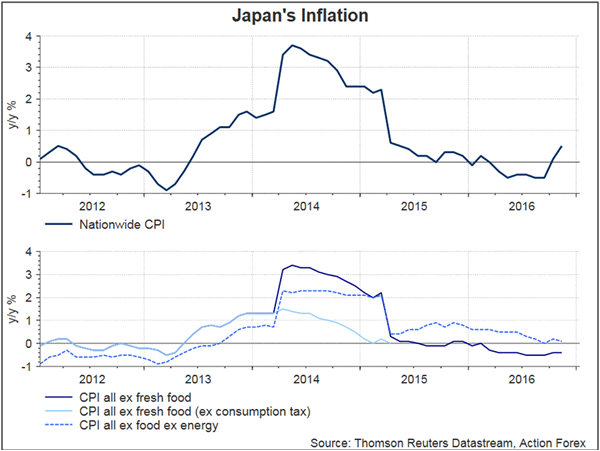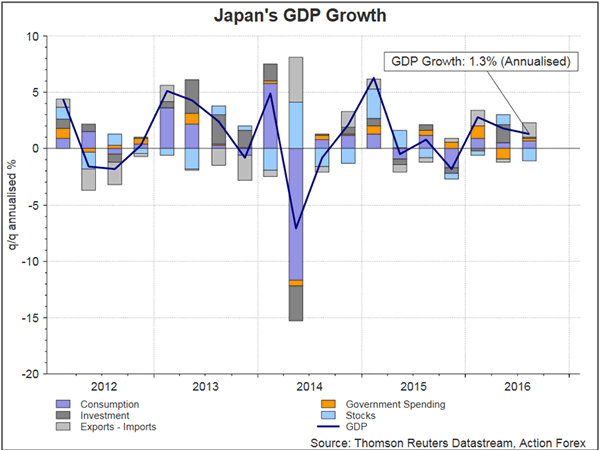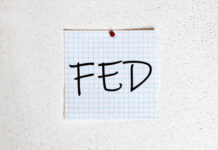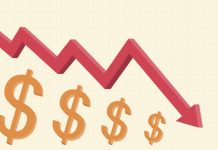Recent correction does not change our relatively positive outlook over USDJPY this year. Donald Trump’s victory at the US presidential election last November triggered sharp rally in interest rates and USD, facilitated by unwinding of USD shorts and opening of USD longs. Despite a pullback after soaring to a recent high 118.66 in mid-December, reflation trades, hinging on the bets that Trump’s administration would drive quicker growth and inflation, remain in play and should push USDJPY higher after consolidation. Yield curve targeting announced in September indicates that BOJ would strive to keep the 10-year JGB yields close to its target by buying sufficient amounts of bonds. This, together with the sharp rise in US yields, helps accelerate divergence of Japanese yields from those in the US, pressuring Japanese yen. We do not feel surprised if prices corrects to 110-112 in 1Q17. Rather, it offers a buying opportunity for a resumption of recent rally. Risk to USDJPY’s strength is slower-than-expected and/or milder-than-expected implementation of Trump’s pro-growth policy.

BOJ’s Shift to Yield Curve Control. In September, BOJ announced a policy called “QQE with Yield Curve Control”, effectively shifting its monetary stimulus from money supply expansion to interest rate control. As mentioned in the accompanying statement, the new policy framework consists of two major components, namely, ‘yield curve control’ in which the Bank will control short-term and long-term interest rates, and ‘inflation-overshooting commitment’ in which the Bank commits itself to expanding the monetary base until the year-on-year rate of increase in the observed consumer price index (CPI) exceeds the price stability target of 2% and stays above the target in a stable manner. For “yield curve control”, BOJ noted that it would purchase JGBs so that 10-year JGB yields would remain around 0%. The purchases would be conducted more or less in line with the current pace, an annual pace of increase in the amount outstanding of its JGB holdings at about 80 trillion yen. BOJ also noted that JGBs with a wide range of maturities would continue to be eligible for purchase, while the guideline for average remaining maturity of the Bank’s JGB purchases will be abolished. For short term rate, BOJ would apply a -0.1% rate to the Policy-Rate Balances in current accounts held by financial institutions at BOJ. In a nutshell, BOJ would strive keep its 10-year government bond yield at 0%, in contrast with usual central bank practice of controlling only short-term rates.
The chart below shows that USDJPY has been highly correlated with US-Japan 10-year yield spreads, over the past months. Hopes that Trump’s pro-growth policy would drive higher economic expansion and inflation, and facilitate a tighter monetary policy stance, have lifted Treasury yields and USD of late. With the market shy of pricing in three Fed funds rate hikes (as signaled in the December dot plot) this year, there is room for USD to rally further should incoming macroeconomic data eventually convince traders that more rate hikes are possible. Fed’s hawkish and BOJ’s determination to keep long-term yields near 0% reveal monetary policy divergence and help widening yield differential, a factor facilitating the rise of USDJPY
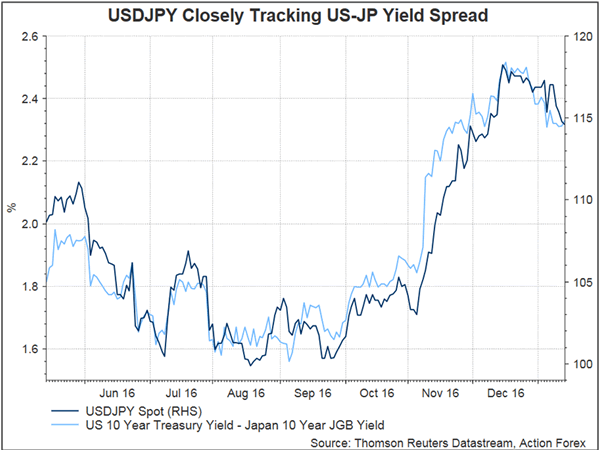
Oil Price and Inflation Outlook:
Energy price contributes to about 7% of US headline inflation. Yet, the correlation of the two can be as higher as 0.96, say, in October. The synchronized decline in USDJPY and crude oil prices over the past weeks is not coincidental, but driven by diminished inflation expectations amidst falling oil prices. If crude oil prices manage to extend gains as driven by tightening of global demand/supply fundamentals this year, inflation expectations, and therefore yields, should climb higher, and vice versa.

Japan’s inflation expectations have remained subdued. BOJ’s December survey shows that only 64.7% of the respondents forecast consumer price to rising this year. This marks a drop from 65.1 in the previous quarter and the lowest since 4Q12. As noted in the December monetary statement, BOJ acknowledged that the year-on-year CPI (CPI, all items less fresh food) has been “slightly negative” and that “inflation expectations have remained in a weakening phase”. The central bank continued to expect inflation to increase towards its 2% target eventually. While BOJ upgraded its economic assessment, the Cabinet Office released the upgraded estimates in December. It now expects real GDP to grow +1.5% in the next fiscal year starting April 1, up from +1.2% previously. Inflation would was revised lower to +1.1% from +1.4% previously. The Cabinet Office also unveiled that the government’s initial budget for next year would increase to 97.5 trillion yen. Weakness in Japanese yen would raise import price while higher oil price might help lift inflation, we expect to stay far below BOJ’s +2% target. This suggests that BOJ would at least maintain the existing stimulus measures, i.e. keeping interest rates, both long term and short term, at exceptionally low levels.
